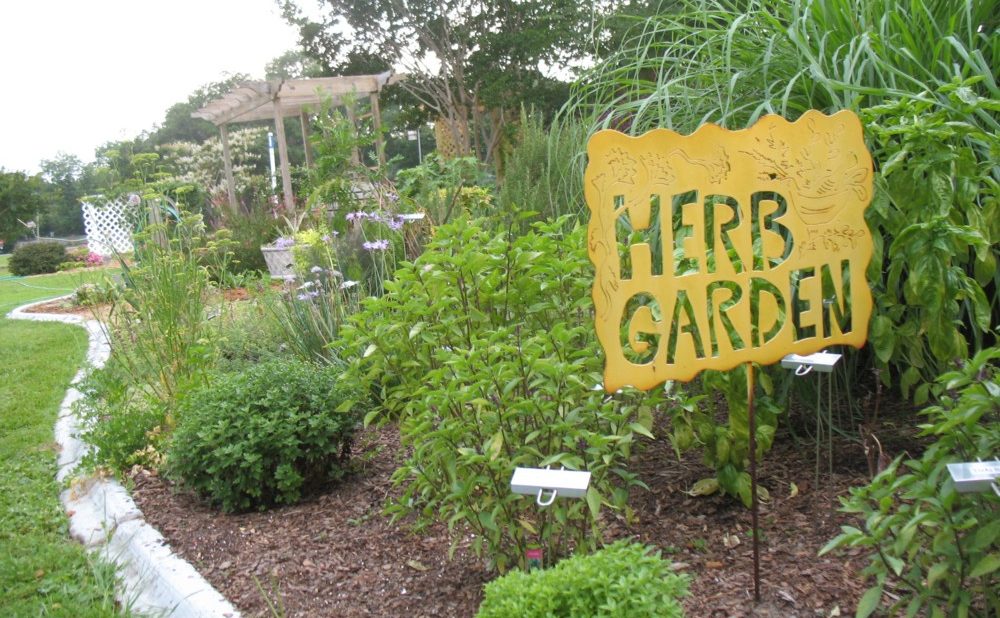
by Roy Carter | May 12, 2015
Herbs are plants that are grown for the special flavor and aroma of their various parts. They are used mainly to season, enrich, or otherwise improve the taste or smell of certain foods. Since they are not classified as vegetables. Since their growth habits and cultural requirements are similar, herbs are often included with vegetables in the garden.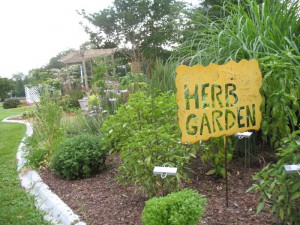
One of the best ways to enjoy year round gardening is to plant an herb garden. Herbs are easy to grow, they require very little care, and they don’t take up much room. Even if you don’t have a large backyard, you can still grow herbs successfully. A small garden bed, a window box, or even a few clay pots, can provide you with fresh, aromatic herbs year round. Herbs are rapid growers and they have a wide variety of uses in the home. They can be used either fresh or dried and when dried they’ll keep for long periods of time.
Herbs are fairly easy to grow. A good garden soil that’s free of weeds and close to a water supply will keep your herbs healthy and growing rapidly. If you can, plant herbs on a narrow strip of land, preferably at the border of your vegetable garden. This will keep your herbs easy to reach. If you scatter them across a wide garden plot, you’ll end up having to walk over the plants to reach and gather them unless you can provide some pathways within your garden. Of course, if you’re growing herbs in window boxes or clay pots, this won’t be a problem.
Dill is probably the easiest and the hardiest herb you can grow. It’s usually planted in late fall and early winter because of its ability to withstand cool temperatures. It may also be planted in the spring. Dill isn’t particularly fussy about its soil so any all-purpose soil that’s suitable for your regular garden vegetables is fine for dill. Another plus is that dill is rarely bothered by any diseases or insects. Fresh dill leaves add excellent flavor to salads and cream sauces, and as a dried herb, dill is well known for the distinct flavor it gives to pickles.
Another popular herb enjoyed by gardeners is sweet basil. This herb is an annual, and it can be replanted in the same area year after year. Basil is also used both fresh and dried. It is widely used as a flavoring for soups, meats and fish. One word of caution: don’t over plant this one. A few basil plants will usually provide more leaves and flowers than an entire family can use in a year.
A few plants, such as sage, balm, and rosemary can be propagated best by cutting. Stems from new growth or the upper parts of older stem make the best cutting for easiest rooting. Cut the stem into 3 to 4 inch pieces each containing a set of leaves or leaf buds near the upper end. To prevent wilting place the cutting in water as soon as they are removed from the plant. A shallow box filled with 4 to 5 inches of a mixture of clean sand, peat, and perlite makes a good root bed. Insert the cutting to a depth of one half-to two thirds their length in the moist mixture; then saturate the mix with water. Place the box in a protected place and keep moist (but not sopping wet) continuously until roots develop in about two weeks. Continue to water until the cuttings are ready to set out in pots or in the garden.
Such plants as thyme, winter savory and marjoram can be propagated by simple layering, which consist of covering the lower portion of the side branches with soil, leaving much of the top of the plant exposed. When the covered part of the stem have rooted, they can be cut from the parent plant and set as individual plants.
Older plants of chive, rosemary and tarragon can be multiplied by dividing the crown clumps into separate parts. These divisions can be set as individual plants.
Mint spreads rapidly by means of surface or underground runners that may grow several feet from the parent plant. The runners, with roots attached, can be removed and transplanted to other locations
Obviously, the list of herbs which grow very well in Florida is quite lengthy, so we won’t be able to go into all of them here. If you can keep in mind just a few points about herb gardens, maybe you can enjoy the virtues of some of these herbs yourself. Remember that herbs are generally very easy to grow and can be adapted to either outdoor garden or indoor container growing conditions. For just a small amount of effort, growing herbs can provide you with year-round gardening satisfaction.
For more information see UF/IFAS Gardening Solutions.

by Eddie Powell | Apr 14, 2015
Growing wholesome, healthy vegetables in a container are a way of life these days. Here are some easy and less expensive tips for creating that bucket garden.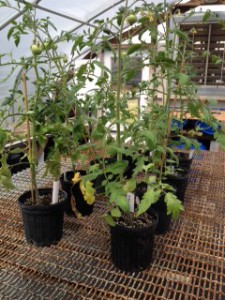
- In a large container or on a plastic mat on the ground, mix garden soil and compost in a 2:1 ratio. Two scoops of soil and one of compost, add the recommended quantity of slow release fertilizer from product label
- Drill 6 to 8- ½ inch holes in the bottom of the 5-gallon buckets. Make sure that the buckets did not contain toxic materials!
- Line the bottom of the bucket with gravel. You may substitute broken pottery or sticks that are broken in short links
- Fill the bucket to within 3 inches of the top of the container
- Place container in sunny spot that will allow drainage
- Plant chosen vegetable with two seeds in center of the container
- Water well and keep moist but not wet
- Place plant support around seeds
Plant requirements:
- Nutrients. Basic needs in plants are Nitrogen (N), Phosphorus (P), Potassium (K). These are listed on all fertilizers as a ratio, example – 8-8-8 contains 8% Nitrogen, 8% Phosphorus, and 8% Potassium and the remaining 76% is a filler. Soils contain many more trace minerals and they are listed on the fertilizer label including directions for use and amounts
- Sunshine or artificial sources of light (grow lights).
- Water. Soil must be kept moist but not wet. Wet soils will create root-rot and encourage fungus. Measure moisture by pinching the soil to see that the soil is moist but never wet. Adding water as needed; plants in hot areas will need much more water than plants in cool spots. Wilted plants need more water!
- Carbon Dioxide (CO2). Plants absorb CO2 and give off Oxygen making them VERY important to human and all animal life.
- Proper Temperatures. Plants will die when it is either too hot or too cold. Make sure that if your plants are outside and the temperature goes below freezing, the plants must be protected or brought inside.
Resources:
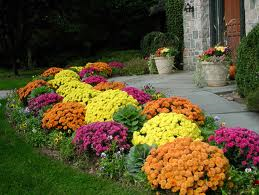
by Larry Williams | Sep 9, 2014
The Emerald Coast Home Show, Health Fair and Business Expo will include lawn and landscape seminars and an information booth hosted by the Okaloosa County Master Gardeners. This event will take place September 13 and 14 at the Emerald Coast Convention Center, 1250 Miracle Strip Parkway in Fort Walton Beach. The horticulture seminars will be provided by the UF/IFAS Extension Office in Okaloosa County.
 A feature of the Emerald Coast Home Show Health Fair and Business Expo will be an information booth hosted by the Okaloosa County Master Gardeners. Master Gardeners will be on hand to answer your gardening questions and to distribute information pertinent to gardening and lawn care on the Gulf Coast.
A feature of the Emerald Coast Home Show Health Fair and Business Expo will be an information booth hosted by the Okaloosa County Master Gardeners. Master Gardeners will be on hand to answer your gardening questions and to distribute information pertinent to gardening and lawn care on the Gulf Coast.
In addition to an information booth hosted by Master Gardeners, free educational seminars will be provided. On Sunday, September 14, I will provide a one hour seminar at 1p.m. entitled “Preparing Your Lawn for Fall and Winter.” This presentation will answer questions concerning preparing your lawn for the dormant period of winter. What’s the truth about” winterizer” fertilizers? Do you need to “winterize” your lawn? How should you water your lawn through the fall and winter? Should you overseed your lawn with annual ryegrass? What should you do about winter weeds in your lawn? What lawn pests are active during fall and winter? Learn the answers to these questions and the truth about winter lawn care for North Florida by attending the Preparing Your Lawn for Fall and Winter seminar.
The complete schedule of free seminars includes the following.
Saturday, September 13
11a.m. Margaret Stewart – Herbs, growing, using and preserving
1p.m. Scott Berry – Orchid basics
3 p.m. Karen Kirk-Williams – Great plants for fall and winter color
Sunday, September 14
1 p.m. Larry Williams – Preparing Your Lawn for Fall and Winter
2 p.m. Marie Harrison – Help! Pollinators in peril
The Emerald Coast Home Show, Health Fair and Business Expo will be open September 13 from 10 a.m. to 6 p.m. and September 14 from 11 a.m. to 4 p.m. and offers free admission, door prizes and giveaway items along with 100 vendors and free health care evaluations.
Visit www.emeraldcoasthomeshow.com for more information.

by Taylor Vandiver | Jun 3, 2014
In a world of limited time and space, container gardens seem to make more and more sense. Poor soil and no place to put plants in the ground are no longer good excuses for not being able to enjoy the simple pleasures of gardening. Container gardening allows the individual to create gardens to fit any situation. Gardening in containers can be just as rewarding as having a full-size garden.
There are a few items to consider when you are planning your container garden. The first is the plants you intend to use. If you are planting more than one plant in the same pot be sure that all your plants meet the same requirements. The requirements you should consider are amount of light, amount of water, climate and fertilizing needs. Some other things you might want to think about when planning your container garden are height, color, and texture. A nice variation of these elements will make your container gardens more attractive and increasingly more interesting to look at.
The next step in container gardening is choosing your container. A good rule of thumb is: “Anything that holds soil and has drainage holes in the bottom may be transformed into a container garden.” It can be a pot you purchased from the local gardening center or an old bathtub you picked up off the side of the road. However, be sure that the size of the container matches the current and potential size of your plant. For vibrant plant growth, the containers must provide adequate space for roots and soil media, allowing the plant to thrive.
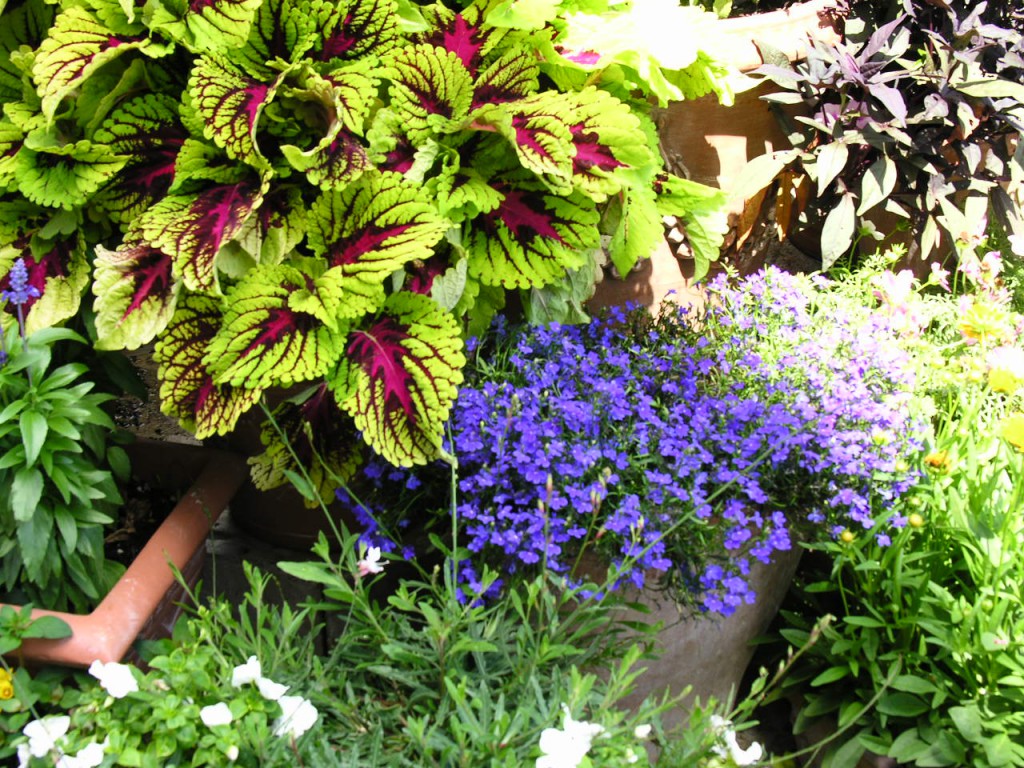
Colorful containers bring life to your small spaces.
Next on your list is choosing a soil for your container. Container soils need have good aeration and decent drainage, while still being able to retain enough moisture and nutrients for plant growth. When choosing what to use in containers, never use garden soil by itself. When garden soil is added to a container, both drainage and aeration are severely impeded, and the results are plants that grow poorly or not at all.
Container soils are often referred to as soilless or artificial media, because they literally contain no soil. They are commonly composed of various media such as peat moss, perlite, vermiculite, bark and coir fiber (ground coconut hulls) in a variety of mixes. When using soilless media remember t0 moisten it slightly before planting. Fill a tub with the media, add water and lightly fluff the media to dampen it. This will keep the mixture from becoming hydrophobic (unable to take up water) throughout its life in the container. When adding media to your containers, never fill the pot to the top. You should leave about a one-inch space between the top of the soil and rim of the pot. This will make watering the pot easier as it provides a place to “put water” and not have it run over the edge.
When watering your container gardens, the best time to do so is in the morning. Watering in the morning allows the leaves of your plants and soil to dry out, preventing diseases and viruses. Remember that overwatering is the most common reason for fatalities in container gardens. Check your soil by pushing your finger into the media; if the media is moist don’t water it. When it comes to fertilizing your container gardens, fertilize only as needed. Over-fertilization will result in a buildup of salts and may burn the roots of your plants. Try to fertilize your plants during the growing season, and only if needed during the dormant seasons.
The most important objective when container gardening is to be creative. Maybe, try a variety of plants in one container garden. While an nicely put together individual container can be quite impressive, think what might happen if you put several containers together in a group. Also, don’t limit your container gardens to flowers–many vegetables can be grown in a container and actually do quite well. There really is no limit to what can be done in a container!
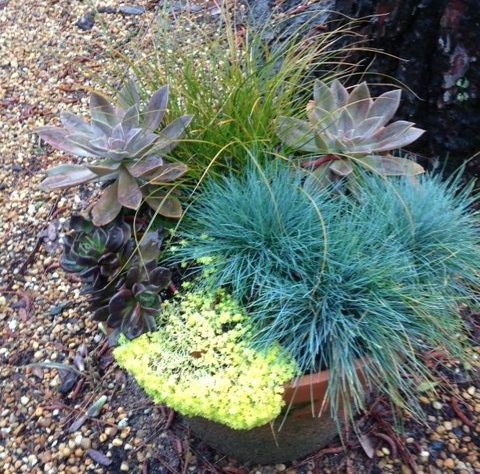
by Julie McConnell | Apr 1, 2014

Container garden. Image: Julie McConnell, UF/IFAS
Living in a condo, apartment, or home with small yard does not mean you can’t garden at home. Whether you are interested in edible plants or ornamentals you can create a fit that is right for your space by using containers.
The first step in container gardening is the same as for traditional landscaping. First, asses your site to determine the cultural situation. Is it sunny or shady? Is water available from rainfall or from a nearby spigot? Will salt or wind be a factor? Are there height and width limitations? All of these need to be taken into consideration when you are planning to plant. These are elements that we have very little control over, so it is best to choose the right plants for the place you have.
Choose a container that will allow for adequate root growth and good drainage. If growing annuals, perennials, or small vegetables, a pot that is 12-18” deep should be sufficient. For shallow rooted or plants that like dry conditions you can go smaller. If plants grow tall make sure that the weight of the soil and pot is enough to keep it upright in gusty winds. It is not necessary to buy a container, you can reuse something as long as the water will drain and it is sturdy. Large containers may not need to be filled completely, but can be filled with a lightweight filler such as upside down nursery pots, water or soda bottles with lids, or packing peanuts. Choosing a light weight filler material makes the container easier to turn or relocate if needed and reduces the cost of potting soil.
Once you have determined site conditions, select the type of plants you would like to grow. When choosing edibles, the amount of sunlight available may be a limiting factor. Although some herbs and vegetables may benefit from a little bit of shade, they still need a bright location in order to produce well. If your site is very shady, consider shade loving ornamentals such as fern, hosta, and impatiens.
Understand the sunlight, water, and fertilizer needs of each plant. Group plants together that have similar requirements because they will receive the same care. Most herbs like a hot, dry situation and very little to no fertilizer. Grouping one of these herbs with a tomato plant that needs consistent watering and regular fertilizer will create a situation where one plant will perform poorly.
Container gardens require more care than plants in the ground because they dry out faster and may get no water from rainfall, if placed in a covered area. Consider using micro irrigation designed for containers or choose plants with low water needs such as the grasses and succulents.
To read more about container gardening read Container Gardening for Outdoor Spaces ENH1095.
The Foundation of the Gator Nation
An Equal Opportunity Institution
by Julie McConnell | Jan 21, 2014
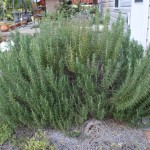
Rosemary
Rosemary (Rosmarinus officinalis) is an attractive evergreen woody perennial and a culinary herb that grows well in the Florida Panhandle with very little attention.
Rosemary is quite tough and thrives in hot, dry spots with well-drained soil. All plants require some water to become established (the time it takes to grow enough roots to support the plant without watering). Once established, it responds well to neglect as long as it is given sunlight, drainage, and air circulation.
Mature plants can grow to be over four feet tall by four feet wide, but may be kept a little more compact with pruning. Leaves are harvested to use in recipes calling for fresh rosemary or can be dried for later use. To read more about growing and cooking with herbs, please read the following EDIS publications.
Herbs in the Florida Garden
Cooking with Fresh Herbs










